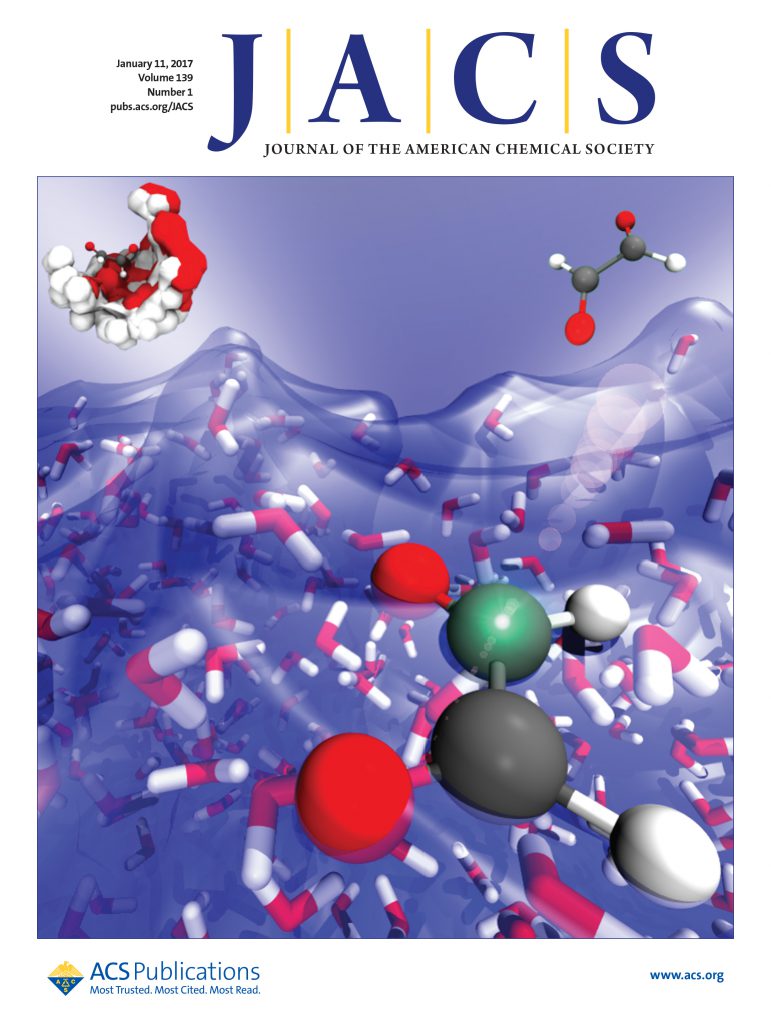Catalytic Activity of an Ensemble of Sites for CO2 Hydrogenation to Methanol on a ZrO2-on-Cu Inverse Catalyst
IF 15.6
1区 化学
Q1 CHEMISTRY, MULTIDISCIPLINARY
引用次数: 0
Abstract
The significant increase in CO2 emissions from heavy fossil fuel utilization has raised serious concerns, highlighting the need for effective methods to convert CO2 into value-added chemicals. Here, we report a computational investigation on the catalytic activity of ZrO2-on-Cu inverse catalysts for CO2 hydrogenation to methanol, considering highly dispersed ZrO2 trimers on Cu (111). Such clusters present a large ensemble of formate-containing configurations, Zr3On(OH)m(OCHO)l, making the evaluation of the catalytic activity very challenging. We found that the sites on the various catalyst configurations exhibit markedly different activities for formate hydrogenation, despite their similar free energy and composition. To understand these differences in reactivity, we examined the structural and electronic nature of the low free-energy catalyst configurations and identified that the energy of the lowest unoccupied orbital of the reacting formate, modified by its binding with the catalytic site, is a descriptor for the reaction energy of the formate hydrogenation step. From there, we screened an ensemble of catalyst structures using this descriptor to predict highly active metastable catalyst configurations and computed the reaction pathways and transition states for formate hydrogenation. From this investigation, we distinguished reactive from nonreactive sites and formate species on the ZrO2/Cu inverse catalyst based on structural and electronic features. We showed that rare metastable configurations control the activity. Additionally, an efficient method for examining the reactivity of a large number of coexisting catalyst structures was developed.

ZrO2-on-Cu逆催化剂催化CO2加氢制甲醇的活性研究
大量使用化石燃料所产生的二氧化碳排放量的显著增加引起了严重的关注,突出表明需要有效的方法将二氧化碳转化为增值化学品。在这里,我们报告了一项计算研究,考虑到Cu上高度分散的ZrO2三聚体,ZrO2-on-Cu反催化剂对CO2加氢制甲醇的催化活性(111)。这种簇呈现出大量的含甲酸构型Zr3On(OH)m(OCHO) 1,这使得催化活性的评估非常具有挑战性。我们发现,不同构型催化剂上的位点虽然自由能和组成相似,但甲酸酯加氢活性却有显著差异。为了理解这些反应性的差异,我们检查了低自由能催化剂构型的结构和电子性质,并确定了甲酸酯反应的最低未占据轨道的能量,通过与催化位点的结合进行修饰,是甲酸酯加氢步骤反应能量的描述符。在此基础上,我们使用该描述符筛选了一系列催化剂结构,以预测高活性亚稳催化剂构型,并计算了甲酸氢的反应途径和过渡态。通过本研究,我们根据结构和电子特征区分了ZrO2/Cu反相催化剂上的活性位点和非活性位点以及甲酸种类。我们发现罕见的亚稳态构型控制着活性。此外,还开发了一种检测大量共存催化剂结构反应性的有效方法。
本文章由计算机程序翻译,如有差异,请以英文原文为准。
求助全文
约1分钟内获得全文
求助全文
来源期刊
CiteScore
24.40
自引率
6.00%
发文量
2398
审稿时长
1.6 months
期刊介绍:
The flagship journal of the American Chemical Society, known as the Journal of the American Chemical Society (JACS), has been a prestigious publication since its establishment in 1879. It holds a preeminent position in the field of chemistry and related interdisciplinary sciences. JACS is committed to disseminating cutting-edge research papers, covering a wide range of topics, and encompasses approximately 19,000 pages of Articles, Communications, and Perspectives annually. With a weekly publication frequency, JACS plays a vital role in advancing the field of chemistry by providing essential research.

 求助内容:
求助内容: 应助结果提醒方式:
应助结果提醒方式:


